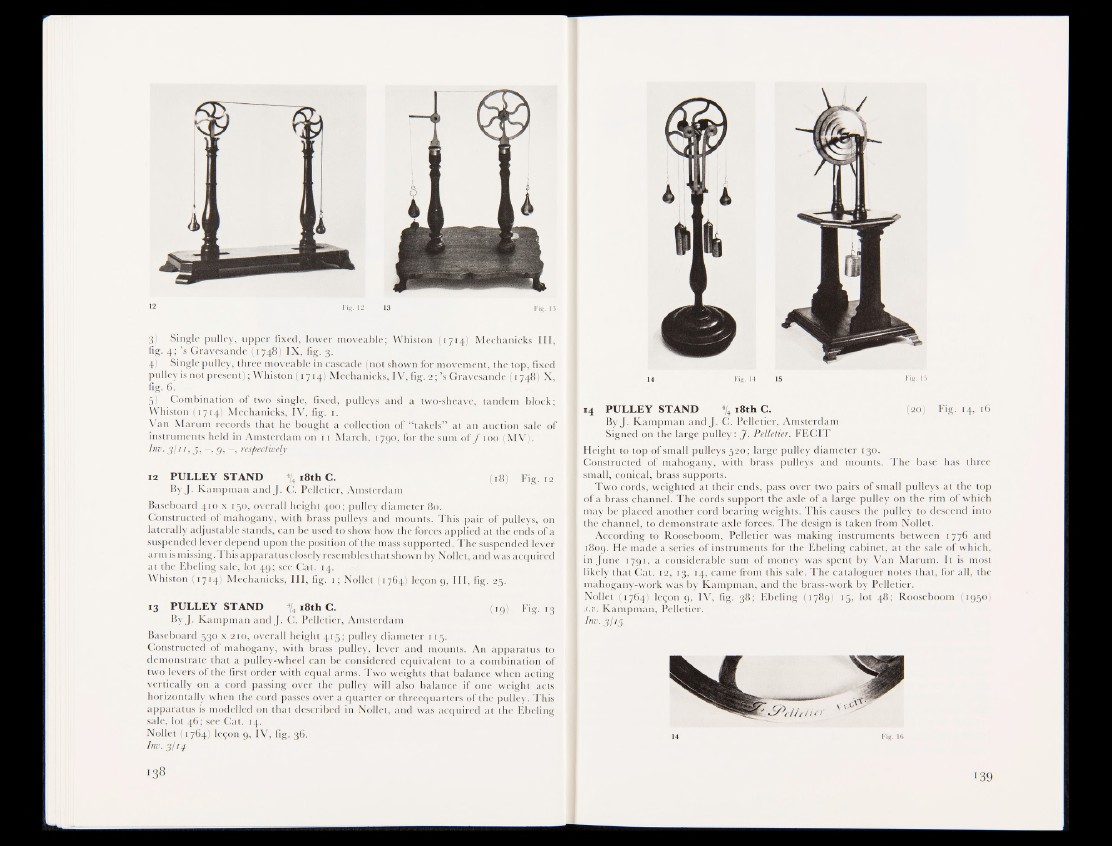
12 Fig. 12 13
3) Single pulley, upper fixed, lower moveable; Whiston (WHBMechanicks III,
fig. 4; ’s Gravesande (1748) IX, fig. 3.
4) Single pulley, three moveàble in cascade (not shown for movement, the top, fixed
pulley is not present) ; Whiston (1714) Mechanicks, IV, fig. 2 ; ’s Gravesande (1748) X,
fig. 6.
5) Combination of two single, fixed, pulleys and a two-sheave, tandem block;
Whiston (1714) Mechanicks, IV, fig. 1.
Van Marum records that he bought a collection of “ takels” at an auction sale of
instruments held in Amsterdam on 11 March, 1790, for the sum of ƒ too (M V ^ B
Inv. 3/11, 5, -, g, —, respectively
12 PULLEY STAND 4/4 18th C. Fig. 12
By J. Kampman and J. C. Pelletier, Amsterdam
Baseboard 410 x 150, overall height 400; pulley diameter 80.
Constructed of mahogany, with brass pulleys and mounts. This pair of pulleys, on
laterally adjustable stands, can be used to show how the forces applied at the ends of a
suspended lever depend upon the position of the mass supported. The suspended lever
arm is missing. This apparatus closely resembles that shown by Nollet, and was acquired
at the Ebeling sale, lot 49; see Cat. 14.
Whiston (1714) Mechanicks, III, fig. 1; Nollet (1764) leçon 9, III, fig. 25, ■
13 PULLEY STAND 4/4 18th C. vij^Big) Fig. 13
ByJ. Kampman and J. C. Pelletier, Amsterdam
Baseboard 530 x 210, overall height 415; pulley diameter 115,
Constructed of mahogany, with brass pulley, lever and mounts. An apparatus to
demonstrate that a pulley-wheel can be considered equivalent to a combination of
two levers of the first order with equal arms. Two weights that balance when acting
vertically on a cord passing over the pulley will also balance if one weight acts
horizontally when the cord passes over a quarter or threequarters of the pulley. This
apparatus is modelled on that described in Nollet, and was acquired at the Ebeling
sale, lot 46; see Cat. 14.
Nollet (1764) leçon 9, IV, fig. 36.
Inv. 3/14
14 Fig. 14 15 Fig. 15
14 PULLEY STAND 4/4 18th C. (20) Fig. 14, 16
ByJ. Kampman and J. C. Pelletier, Amsterdam
Signed on the large pulley : J. Pelletier. FECIT
Height to top of small pulleys 520; large pulley diameter 130.
Constructed of mahogany, with brass pulleys and mounts. The base has three
small, conical, brass supports.
Two cords, weighted at their ends, pass over two pairs of small pulleys at the top
of a brass channel. The cords support the axle of a large pulley on the rim of which
may be placed another cord bearing weights. This causes the pulley to descend into
the channel, to demonstrate axle forces. The design is taken from Nollet.
According to Rooseboom, Pelletier was making instruments between 1776 and
1809. He made a series of instruments for the Ebeling cabinet, at the sale of which,
in June 1791, a considerable sum of money was spent by Van Marum. It is most
likely that Cat. 12, 13, 14, came from this sale. The cataloguer notes that, for all, the
mahogany-work was by Kampman, and the brass-work by Pelletier.
Nollet (1764) leçon 9, IV, fig. 38; Ebeling (1789) 15, lot 48; Rooseboom (1950)
4,;S. Kampman, Pelletier.
Inv. 3li5
14 Fig. 16